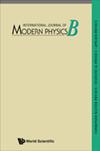Double stratification impacts on MHD flow of micropolar nanofluid over a stretching surface inserted in porous medium
IF 2.8
4区 物理与天体物理
Q2 PHYSICS, APPLIED
引用次数: 0
Abstract
A comprehensive analysis of double stratification impacts on the MHD flow of a nanofluid produced by a porous stretching sheet has been conducted by using a numerical approach. The convective boundary conditions (CBCs) and Newtonian heating (NH) cases have been particularly considered in this problem. The governing equations defined in partial differential equations (PDEs) form are converted into ordinary differential equations (ODEs) by using appropriate transformations to meet the requirement of the used numerical method which is bvp4c in the MATLAB software package. Moreover, the numerical findings of the ODEs are displayed via graphical and tabular forms. The impacts of different flow parameters used in particular problem are discussed for the profiles of the velocity, temperature and concentration of micropolar nanofluid along the values of coefficient of skin-friction [Formula: see text], Nusselt number [Formula: see text], the Sherwood number [Formula: see text] and in relation with the variation parameters in general, CBC and NH are calculated to get a clear insight into the flow situation. Some of the findings show that the skin friction increases by increase in magnetic, permeability and material parameters in all cases but the skin friction is reduced by increasing the thermophoresis parameter for CBC and NH cases, respectively. Microrotation profile decreases when material parameter increases, whereas microrotation profiles enhance with increase of the magnetic field and porosity of porous medium.微极性纳米流体在多孔介质中拉伸表面上的双重分层对MHD流动的影响
采用数值方法全面分析了双分层对多孔拉伸片纳米流体MHD流动的影响。该问题特别考虑了对流边界条件(CBCs)和牛顿加热(NH)情况。根据MATLAB软件包中的bvp4c数值方法的要求,将以偏微分方程形式定义的控制方程通过适当的变换转化为常微分方程。此外,通过图形和表格形式显示了ode的数值结果。讨论了具体问题中不同流动参数对微极纳米流体的速度、温度和浓度沿表面摩擦系数[公式:见文]、努塞尔数[公式:见文]、舍伍德数[公式:见文]的分布的影响,并计算了CBC和NH与一般变化参数的关系,以清楚地了解流动情况。一些研究结果表明,在所有情况下,皮肤摩擦都随着磁性、导磁率和材料参数的增加而增加,但在CBC和NH情况下,皮肤摩擦分别随着热泳参数的增加而减少。微旋转曲线随材料参数的增大而减小,随磁场和多孔介质孔隙度的增大而增大。
本文章由计算机程序翻译,如有差异,请以英文原文为准。
求助全文
约1分钟内获得全文
求助全文
来源期刊

International Journal of Modern Physics B
物理-物理:凝聚态物理
CiteScore
3.70
自引率
11.80%
发文量
417
审稿时长
3.1 months
期刊介绍:
Launched in 1987, the International Journal of Modern Physics B covers the most important aspects and the latest developments in Condensed Matter Physics, Statistical Physics, as well as Atomic, Molecular and Optical Physics. A strong emphasis is placed on topics of current interest, such as cold atoms and molecules, new topological materials and phases, and novel low dimensional materials. One unique feature of this journal is its review section which contains articles with permanent research value besides the state-of-the-art research work in the relevant subject areas.
 求助内容:
求助内容: 应助结果提醒方式:
应助结果提醒方式:


